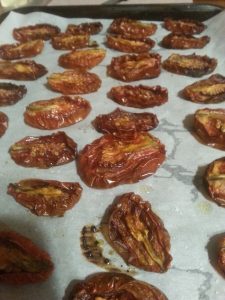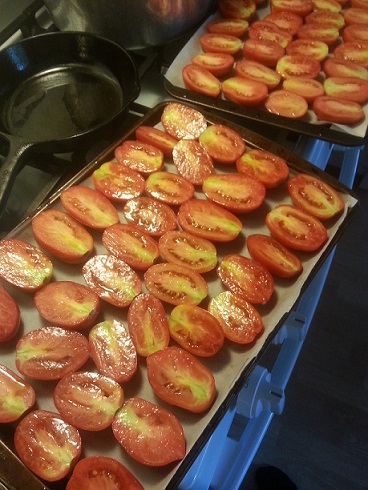I’ve already posted about the lacto-fermented salsa that I made with many of the slicing varieties of tomatoes. Truthfully, I will can/sauce/preserve pretty much any type of tomato. Slicing tomatoes are juicier and seedier than the plum/paste type, so the product generally requires extra boiling and straining. Or you can just learn to deal with seeds in your sauce. While plum types are certainly better, I think it’s senseless to waste the slicer harvest if there’s an alternative (even if it takes a little extra effort).
Tomato sauce happens to be the most popular way to consume tomatoes here in the United States. According to the USDA’s Economic Research Service (ERS), 89% of tomatoes grown in the United States are processing types. And 38% of tomato consumption comes from sauce! So, despite the romantic imagery of heirloom tomato juice running down our chins as we indulge in the season’s harvested gifts, the reality is we eat mostly plum type tomatoes preserved for the off-season months.
Originally, I aimed to make small batches of sauce with the plum varieties in the trial, but I didn’t get around to it. First, it takes a lot of tomatoes to make a worthwhile batch of sauce (worthwhile meaning worth the time and effort to can). Second, it was unseasonably hot in late August and early September, and I couldn’t rationalize the pots of boiling water heating up my un-airconditioned house. And third, well, I had already canned a couple of really large, mixed-variety batches for my household, and I didn’t feel like doing anymore. Alas, I decided to slow-roast each variety on steel baking sheets with a little oil and salt. After 8-12 hours (depending on the variety), the tomatoes shrivel into an almost sun-dried version with a slight chewiness and really concentrated flavor. I make big batches of these, throw them into Mason jars and freeze them. I take them out to throw in soups, sauces, stews, and even to blend with cream cheese or goat cheese for a spread/dip. They are also wonderful fresh on a slice of baguette and a smear of something creamy.

To do this yourself: Wash tomatoes in warm water and allow to dry. Slice them in half vertically, from blossom- to stem-end. Place tomato halves, cut-side up, in a single layer on baking sheets that have been lined with parchment paper. Using a basting brush, brush the tops of the tomatoes with a neutral-flavored cooking oil (I used vegetable for neutrality, but olive oil would be classically delicious). Next sprinkle salt on top. I used 1/4 tsp. per baking sheet, which were all the same size. Place tomatoes in a preheated 200 degree F oven. Allow to roast 8-12 hours, being sure to check them every so often and enjoy the enamoring aroma. When they are done to your liking, remove the baking sheets and allow tomatoes to cool on the trays. When cool, place into jars to store in the freezer or fridge.
For those that are wondering, OSU LB8-7 (this is also the variety in the photos) took the shortest amount of time – 8 hours – and smelled the best and most intense. Plum Perfect took 9.5 hours and Plum Regal took a full 12. These two smelled similar (nutty and cheesy), but the aroma and flavor seemed more fleeting than OSU LB8-7. They were roasted different days though, so I’ll be eager to taste them side-by-side and compare them at next week’s tasting for the Gastropoetics program.
Cheers!

Leave a Reply